Pioneer Mother And Child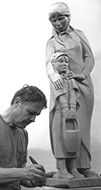
Alaskan Cedar, 42” high, 1990
Timberline Lodge was built entirely by hand at the height of the depression by the WPA, a federal agency created by President Roosevelt to put people back to work. The Friends of Timberline was organized in l978 to participate in the restoration of this treasured landmark. A new wing was built and needed the same kind of hand worked, local art which filled the original building.
Many people helped with the project: some working, some donating money. One donor, who remains anonymous, funded a commission for Paul to carve two figures, one Native American mother with child and one Pioneer mother with child. Shown here is the Pioneer.
When Paul discovered that carving the details of a child wrapped in her mother’s shawl would be nearly impossible using a single block, he figured a way to carve them separately, gluing them together using blind joints. Both mother and child sculptures are currently at the head of the stairs in the new C.S. Price wing at the Lodge.
Arabesque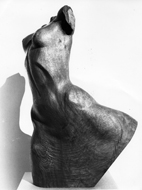
Walnut, 26” x 17” x 12”, 1975
Long cut when it was given to him by a family friend, the large and heavy black walnut forked tree trunk sat in Paul’s studio for a few more years. Though he looked at it many times in passing, it had never announced to him what it wanted to be. This is where the mystery of art enters. One day, for no particular reason that he remembers, Paul turned it upside down. With this simple and seemingly random action, the artist’s muse, that loveliness we all court, animated into a wild dance what had for so long been just a chunk of wood. Paul immediately set to work with his sharpened tools and sure hands. The result is Arabesque, finally righted and set loose to dance as only she can.
Valkyrie
Ceramic, 22” x 12” x 8”, 1984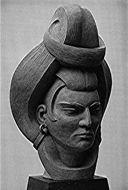
Valkyries, the Norse warrior maidens have long been a subject for artists. Legend has it that these women chose which men died in battle, carrying them then to Valhalla. Paul has had a life-long fascination with these heroic figures and spent three days in l984 sculpting this one. He used the slab and coil method, what ceramicists call piece-meal built.
This technique produced a hollow, half inch thick shell of clay which was then fired without glaze. ‘Valkyrie’s’ columns and swoops of hair serve also as collar, helmet and cloak. He made no model, nor any drawings, but simply started in, finding the form as he went.
Breach
Walnut, 28” high, 1988
 In 1987 Paul offered for sale his wood sculpture of a woman emerging from the sea. He called it ‘Spindrift’, but it was stolen from Timberline Lodge, where it was showing. ‘Breach’ is his replacement sculpture. In retrospect, Paul considers the theft as a heavily disguised blessing, seeing the replacement as a more refined and better executed design.
In 1987 Paul offered for sale his wood sculpture of a woman emerging from the sea. He called it ‘Spindrift’, but it was stolen from Timberline Lodge, where it was showing. ‘Breach’ is his replacement sculpture. In retrospect, Paul considers the theft as a heavily disguised blessing, seeing the replacement as a more refined and better executed design.
A whale’s breaching lunge is the basis for this piece, with Paul hoping that ‘Breach’ shows the tension of the upward surge while remaining all woman. For Paul, the tension nexus is in the flexed hands and the hyper-extended arms.
The Sea Ribbon support, following the form of a kelp frond, is often seen in Paul’s marine theme carvings. Having refined his technique over the years, he can now cut them from the wood using the direct carving method. To do so brings him joy and satisfaction.
Eagle Spirit
Copper, Yellow and White Gold Leaf, 36” x 60” x 27”, 2007, % for art WSAC
Created at life size and perched high on a support beam in the library, ‘Eagle Spirit’ truly soars overhead at Washington High School in Tacoma. Flashing beaten copper as well as touches of gold and silver leaf, it’s a real attention grabber.
Completed only last year, this strikingly realistic Bald Eagle is one of Paul’s most time consuming works. After his painstaking construction of a 24 inch scale model, Paul made a steel armature on which to hang the metal. Using the intaglio method of cutting the negative form, he then carved a separate, full sized wooden block for each part of the eagle’s body. Next, he would lay a sheet of copper across the cut hole in the block and beat it down until the metal was flush up against every part of the wood. If his hammer work was too aggressive, splitting the copper, he started over.
Ed. Note: Perhaps we have all felt moments when the work of carving a thousand little curves or bumps; the repetition of bending, forming, matching; or the unending drudgery of cleanup and sanding have made us question why in the world we ever designed such a piece. Let ‘Eagle Spirit’ serve as a symbol of the way art works. There’s the art – and there’s the work.
Siren
Steatite, 14” x 15” x 8”, 1976, % for art WSAC

She came from one of John Pugh’s first Steatite field stones. Paul bought it back in the ‘60s out of one of the many Willys Jeep loads hauled up from the Rogue River country when John began selling soap stone to the students at the U of O.
After working out the design in a built-up terra-cotta maquette, Paul carved her with hand tools. This is not thought to be difficult with Steatite, but field stones can be a little fussier than quarried stone. Nonetheless, ‘Siren’ was completed in l967 and sold to Olympic College in Bremerton on the peninsula across from Seattle, taking up residence in their library.
Paul isn’t sure of how many mermaids he has carved, but it’s a lot - further proof of his lifelong love of ocean life forms, both real and imaginary. Paul puts it this way, “The imaginative qualities of the sea have always been a big part of me.”
Working Hands Totem
Cement and Ceramic Tiles, 9’ 6” high, 2005 & 6, % for art WSAC

The Duwamish Apprenticeship Education Center on the Georgetown Campus of South Seattle Community College wanted a sculpture commemorating their graduates who were going into the working trades. After all the interviews were over, Paul was selected as the artist for the job; then began the long task of agreeing on a design. Out of these talks emerged the free-standing pillar.
Paul modeled the six workers in individual plaster sections, three for each side. Rubber molds of these sections were produced by Paul’s sculptor son, Matthew. The Apprenticeship Education Center’s faculty than assumed the responsibility of casting the pillar on-site in limestone colored cement.
As well as designing and engineering the pillar, Paul framed the piece with 72 of his handmade tiles. Each tile is a unique adaptation of the totemic hand seen in the art of Indian tribes throughout the Northwest.
Promise
Concrete, 80” high, 1988, % for art OAC
In 1987 Paul Buckner began driving back and forth to Pendleton, Oregon. Before he finished, he had logged over 10,000 miles. The Oregon Art Commission had selected Paul to give a 4 week workshop on sculpture fundamentals at the Eastern Oregon Correctional Institution in Pendleton. At the end of the 4 weeks of study, he was to construct a cement figure symbolizing hope, justice and freedom.
Four men were chosen from the prison population to help with the work. They wanted to include an eagle to show the power of the state as well as their own strength and will.
Prisoners’ strength and will are not allowed much space in jail, but are never forgotten by the inmates.
Paul decided a vulnerable man, shirtless and alone, would be the main theme. His right hand rests on the eagle while his left hand cradles an innocent dove. While the man can never escape the implacable strength of the state, his wistful gaze is forever directed down at the dove with its folded wings.
Torso
Utah Limestone, 16” x 6” x 5”, 1998
As limestone blocks go, it was small, just 16 inches long, sawn off as waste from a larger, purchased block. It contained some interesting sedimentary lines but they were too close against one side for any kind of symmetry. Most folks at the l998 Silver Falls Symposium thought it didn’t look like much of a rock.
That year’s drawing and design instructor saw it differently. He turned it upside down. That’s right; he put the flat, sawn end up and the broken end down. He then began carving a female torso. Paul Buckner not only lives outside the box - he’s never even seen a box.
Using his carving as a tool for instruction, Paul demonstrated how the muscles attach to the iliac crest, that small, just under the skin, knob on each front corner of the pelvis. But this was more than a textbook rendering. TORSO has a sweetness to its curves, a simple elegance of form.
Zostera Marina
Ceramic head with Walnut hair, 16” x 16” x 11”, 1979
The name means sea grass; we’ve all seen waving about in the shallow water at the beach.
In a way, ‘Zostera’ started in l962 when Paul and a student at the U of O bought a truck load of wood blanks from a retiring gun stock carver on River Road in
Eugene. Paul got enough cured hard wood to last him for many years. He still has some of it.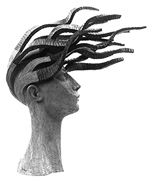
Seventeen years later, Paul went to his stash and selected a walnut gun stock, or two, for her hair. The ceramic head was piece-meal built and fired. The first strand was then carved, hand fitted to a hole in the clay and secured with glue that remains malleable. The second strand was carved to touch the first somewhere along its length where it was pined with a dowel and hard glued. This was repeated until all 10 pieces were attached, finishing the sculpture.
Ancient Seas
Chlorite, 17” x 11” x 9”, 1990
Using another one of John Pugh’s field stones, this time Chlorite, Paul carved a man and a woman in shallow relief. As the piece’s name states, these seas are ancient, prehistoric, even. The woman is shown here among sea creatures that are etched into the polished blackness around them. In Paul’s mind the dancing humans haven’t evolved that far from their swimming companions. He adds the thought that we may yet find ourselves returning to the sea, to flow in some future current of our evolutionary journey.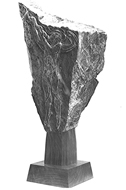
The turning, twisting creatures of ‘Ancient Sea’s’ follow the natural planes of the stone and so, required little stone removal. Perhaps, as viewers, our curious and imaginative minds will want to follow these natural surfaces; to swim and dance in the oceans that Paul Buckner has created.

